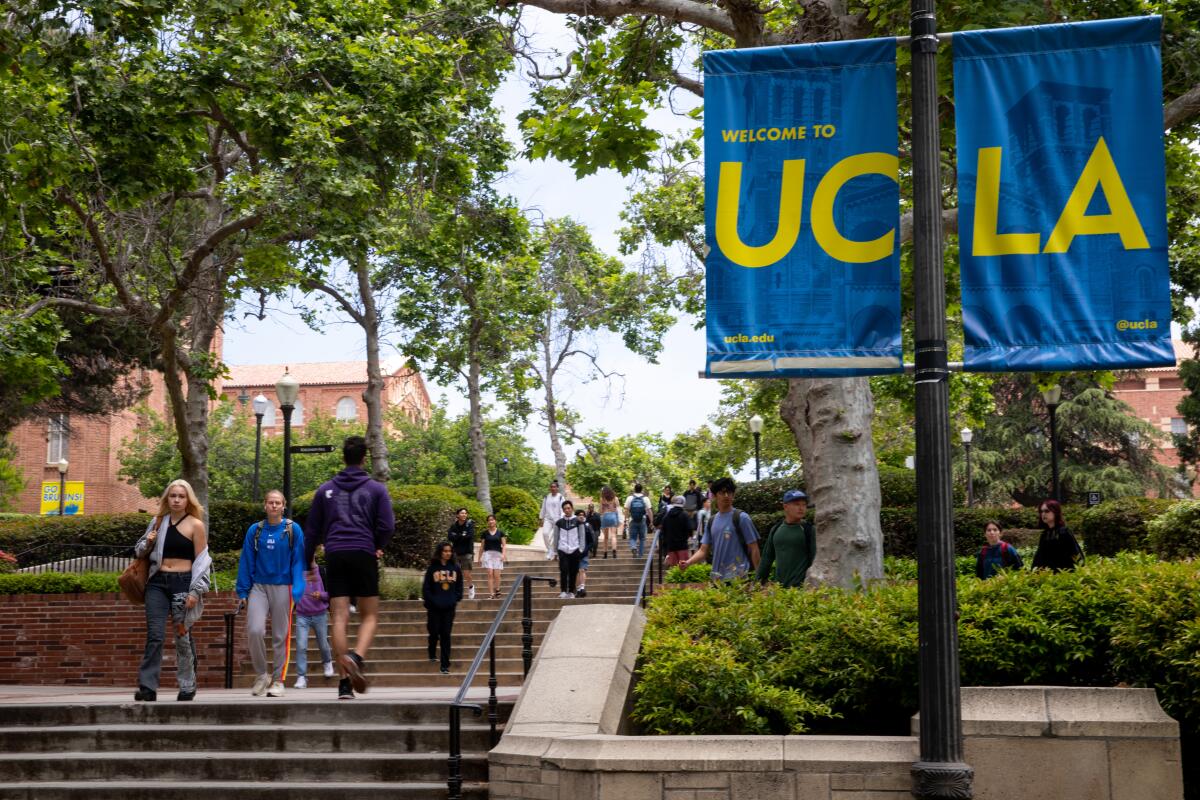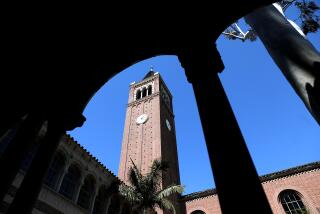Opinion: Want more diversity in schools? Copy the University of California and look to community colleges

- Share via
The Supreme Court’s decision to outlaw the use of race and ethnicity in college admissions late last month was neither unexpected nor profound, even if it was disheartening. Higher education has been dealing with anti-affirmative-action legislation for a long time.
Nine states (five blue and four red) have banned the use of race and ethnicity in admission, most notably California, whose voters passed Proposition 209 in 1996. These state-level prohibitions have passed legal muster after repeated challenges. As a result, colleges and universities as different as UCLA, Miami-Dade College and the University of Nebraska have been forced to develop admissions strategies that do not rely on an applicant’s stated race and ethnicity to create diverse college campuses.
For the record:
12:05 p.m. Feb. 16, 2024This piece incorrectly identifies Eileen Strempel as inaugural dean of the Herb Albert School of Music at UCLA. It is the Herb Alpert School of Music.
Elite institutions, especially private colleges and universities, have insisted that they face unique challenges that require the use of race and ethnicity to help create classes that reflect the diversity of the U.S. But as of last month, that strategy is against the law. Now what?
Community college graduates in healthcare fields can outearn humanities students even from elite universities such as Stanford, UC Berkeley and UCLA, underscoring how much majors can matter.
Ivy league and other peer schools need to do something they’ve never done with any consistency or devotion: widen their enrollment pipeline to welcome transfer students from community colleges in substantial numbers.
Community colleges represent the largest sector of higher education in the U.S., enrolling 41% of all undergraduates in fall 2020 at more than 1,000 colleges. They boast significant racial and ethnic diversity: The Department of Education reports that among all students attending community colleges, 27% identify as Hispanic, 12% as African American and 1% as American Indian or Alaska Native, considerably higher than most percentages in the Ivy League. And among first-time college students entering a community college, surveys show that the vast majority seek to transfer and earn a baccalaureate degree.
Yet Harvard, for example, admits on its website that it only takes 12 transfer students per year.
Most elite institutions have chosen to recruit the bulk of their students directly from high school. Even though they are likely within driving distance of at least one community college, these institutions have not built strong enrollment pipelines with those neighbor schools. But Carleton College economist Nathan Grawe forecasts that high school senior classes will shrink in the coming decade, creating even more incentive for elite universities to open their doors to a broader swath of individuals.
Students attending community colleges form a diverse pipeline for baccalaureate institutions while dodging some of the issues that complicate recruitment efforts for high school graduates. For one, standardized test scores, which are fraught with disparities, are mostly absent from the transfer admissions process. Elite institutions remain devoted to these tests, even in a post-pandemic, test-optional environment. But standardized test scores would be irrelevant for community colleges since they are open-access institutions that generally do not require the SAT or ACT for admission.
Even without the burden of ‘colorblind’ admissions policies, equalizing opportunities for South L.A. students required their perseverance and intensive support.
Moreover, community college students who apply to four-year institutions are evaluated primarily on their grades from college, not high school. Students with good grades in community college have demonstrated they can handle college-level work, unlike high school applicants whose college performance is only an educated guess.
Still, many elite institution leaders object to expanding transfer student enrollments with the fear that open-access community colleges could not possibly prepare these students for the demands of their bachelor’s degree programs.
This received wisdom does not, however, jibe with reality. UCLA is the most selective public system of higher education in the U.S., receiving more applications than any other postsecondary education institution in the nation. The admissions rate (alas) is 9%, consistent with the selectivity rate at the best elite colleges and universities. Yet despite the extraordinary demand for admission at the first-year level, last year UCLA admitted 5,961 transfer students, more than 90% of them from a California community college. Over one-third of UCLA’s fall 2022 class were transfer students.
These individuals represent a rich and significant source of diversity: 34% are from underrepresented groups, 72% receive need-based financial aid and 43% of domestic transfers are first-generation college students. Most critically, publicly available data show that these students graduate at rates similar to those of their first-year counterparts.
If UCLA and the UC system have found a way to balance competition and rigor while still graduating transfer students at high rates, why can’t other elite institutions?
The Supreme Court’s decision closed an important avenue of access to colleges and universities in the U.S. for students from underserved backgrounds. But let’s not compound the error by continuing to ignore America’s community college students who — in California and elsewhere — make an enormous contribution to the diversity and prestige of U.S. higher education.
Stephen Handel is a senior program officer with ECMC Foundation in Los Angeles and was formerly associate vice president of undergraduate admissions for the University of California system. Eileen Strempel is the inaugural dean of the Herb Albert School of Music and a professor of education at UCLA.
More to Read
A cure for the common opinion
Get thought-provoking perspectives with our weekly newsletter.
You may occasionally receive promotional content from the Los Angeles Times.












